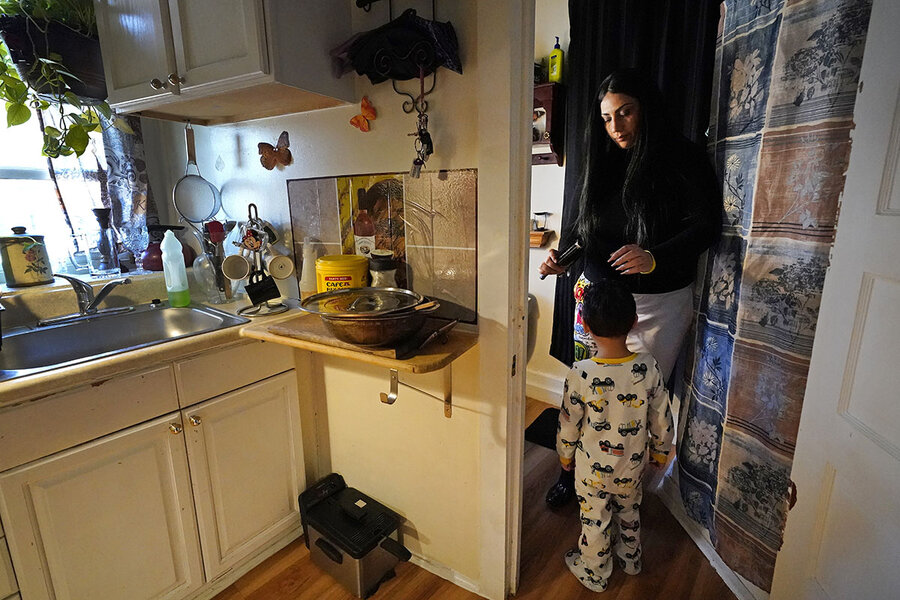With moratorium lifting, can US avoid avalanche of evictions?
Loading...
| Cincinnati
The cliff is here. Sort of.
Ten months and billions of dollars in federal aid later, the eviction moratorium put in place by the Centers for Disease Control and Prevention is set to expire July 31.
It was first put in place after more than 20 million Americans suddenly lost their jobs during 2020 lockdowns.
Why We Wrote This
After more than a year of dire predictions about an avalanche of evictions, there is still some hope for renters – even with the moratorium lifting this weekend. For one thing, most of the federal money to help will be available for years to come.
On the one hand, the U.S. economy has been climbing steadily back out of that pandemic hole. And with so much federal aid earmarked for emergency rental assistance, the avalanche of evictions may be smaller than originally predicted. On the other hand, of the nearly $47 billion allocated since December, only a tiny percentage – about 6% – has been spent as of June, leaving renters – and landlords – in limbo.
“The CDC moratorium has helped a select few tenants,” says Rachel Garland, a lawyer in Philadelphia who helps tenants fight evictions. “[But] the whole idea was not to kick the can down the road, and then have a spike in evictions when the moratoriums ended. The idea was, put the moratoriums in place, but then put other measures in place, such as rental assistance, that would resolve these issues.”
In some ways though, kicking the can is exactly what happened. Housing advocates worry the result could be a flood of evictions after this weekend. Some 14% to 16% of renters say they are behind on rent. While that’s significantly better than in January, it still translates into millions of Americans at risk of losing their home at the same time.
On Friday, the House began work on a possible 11th-hour reprieve, but an extension’s future in the Senate was uncertain.
But there is hope: This month, states, cities, and nonprofits flush with federal cash have raced to get as much money out the door as possible before July 31. And there’s an opportunity to keep funding levels for emergency rental assistance at new highs for years to come. Some housing advocates are cautiously optimistic that long-term alternatives to eviction could be put in place that could offer a less-disruptive way forward for both tenants and landlords.
Just how large a wave of evictions will materialize after the moratorium lifts this weekend remains to be seen. The moratorium itself, first implemented in September 2020, has had holes and exceptions. While evictions slowed, they didn’t stop – so there may not be as much built-up pressure as feared.
The economy has strengthened significantly, though the recovery remains lopsided and different states offer different levels of eviction protection. Landlords say they are also flummoxed that generous pandemic unemployment benefits haven’t translated into rent checks. For their part, tenant advocates point to an economy that’s being threatened by the COVID-19 delta variant – renters in already precarious economic positions are now juggling other complications, such as school opening plans that are still in flux.
Between former President Donald Trump and President Joe Biden, roughly $47 billion has been allotted from Congress in rental assistance funds since December to cover back rent, utilities, and even moving costs. But only $1.5 billion had been spent through the end of May. After a Supreme Court ruling last month that the moratorium couldn’t be extended unless Congress intervened, some progress was made: Another $1.5 billion was distributed in June. Still, a July Treasury statement noted, “While more households are getting help, in many states and localities, funds are still not flowing fast enough to renters and landlords.”
That snail’s pace translates into tenants falling further behind on rent, and landlords continuing to face down mortgages, taxes, and other costs without money coming in.
“It was a little frustrating, knowing [the federal money] was out there, knowing that we had residents that needed it,” says Justin Seger, vice president of residential properties at Hills Properties, which owns several thousand units across the Midwest. “And those balances start to stack up, and that puts a huge burden on landlords” – especially smaller ones who might only own a property or two, he adds. While Mr. Seger has noticed things moving faster in the last month or so, overall he says he’s found charitable organizations much more responsive to tenants’ rental assistance needs.
The moratorium lapsing, however, gives tenants less time to get through the lengthy assistance process.
“The program is working in Kentucky, but it takes time,” says Brandon Holmes, director of housing and weatherization at Northern Kentucky Community Action Commission, which refers both landlords and tenants to the state agency processing applications. “Everyone’s somewhat anxious right now. A lot of it has to do with this uncertainty of actually getting a payment, from a landlord perspective – and from the tenant side, the fear of being evicted.”
But the millions in aid, set to last far past July 31, “might be good to lay the groundwork for eviction prevention infrastructure going forward,” says Mark Lawson, president of the Community Action Agency.
During the pandemic, the Cincinnati nonprofit has helped get $10 million in rental assistance to those in need, versus $300,000 in a typical year. Also, instead of capping help at $2,500 per family, the CAA can now pay arrears back to March 2020.
“We can make a landlord whole – which is very different than before,” Mr. Lawson says. “Tenant assistance is landlord assistance.”
“A prayer and a hope”
For a while, it seemed like Malea Berry was going to make it through the pandemic unscathed. The single mother had a good job working as a pharmacy technician. But after months of her 5-year-old son, Myaire, attending online kindergarten – with only his grandmother available to attempt to guide him through Zoom – she reached a breaking point. She quit her job in October.
“I was exhausted. I was starting to feel depressed, extremely stressed out,” she says. “And I’m like, ‘I can’t allow that to happen, especially right now. It’s too critical. I cannot crash right now.’ So I had to change up everything in my life to be able to keep pushing forward.”
Quitting her job to guide her son through school “obviously completely affected my income, which then caused a snowball effect,” she says. Because she wasn’t fired – and because of the delays she saw with others getting unemployment – she didn’t apply for unemployment benefits.
Money was going fast. She was keeping up with rent, but fell behind on utilities. Her apartment had water damage, but her landlord was unresponsive. She needed to move, but didn’t have the means to do so.
“I didn’t have any cash,” Ms. Berry says. “I was on a prayer and a hope.” After filing paperwork with the CAA in December, money came through in February: First month’s rent and a security deposit on a new apartment, and six months of energy bills. Ms. Berry’s case is one of the success stories of the emergency rental assistance program.
Eviction as a last resort
Philadelphia might be an early example of what successful post-moratorium rental assistance could look like. The goal is to treat eviction as a last resort, not business as usual.
One of the problems with the moratorium and rental assistance was that tenants had to actively opt-in to use them. But there were many tenants – and landlords as well – who didn’t know that help was available, or didn’t know how to seek it. This led to evictions that could have been prevented.
But in Philadelphia, a court order in place until August has created bumpers, requiring landlords and tenants to go into diversion and mediation programs – and then, if necessary, into applying for emergency rental relief – before eviction can be pursued.
By putting the other solutions first, and evictions last, it creates a situation where all available options are pursued, Ms. Garland says. “It solves the problem a lot faster than sitting around waiting for a court date that may or may not solve the problem.”
The case of Ms. Berry shows just how long and drawn out the pandemic’s economic effects can be. She’s since started her own business, with more flexible hours, but still doesn’t quite feel stable. “Honestly, I don’t feel that I’m on the other side,” she says. “I’ve still got plenty of stuff that needs to be paid. I have to catch up; I was just getting my credit together.
“People don’t realize how long it’s going to take for the average person to recover from the COVID situation.”







